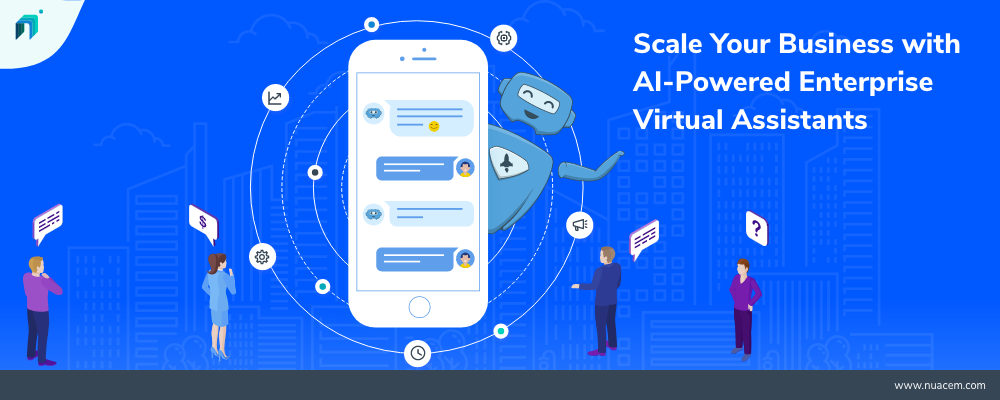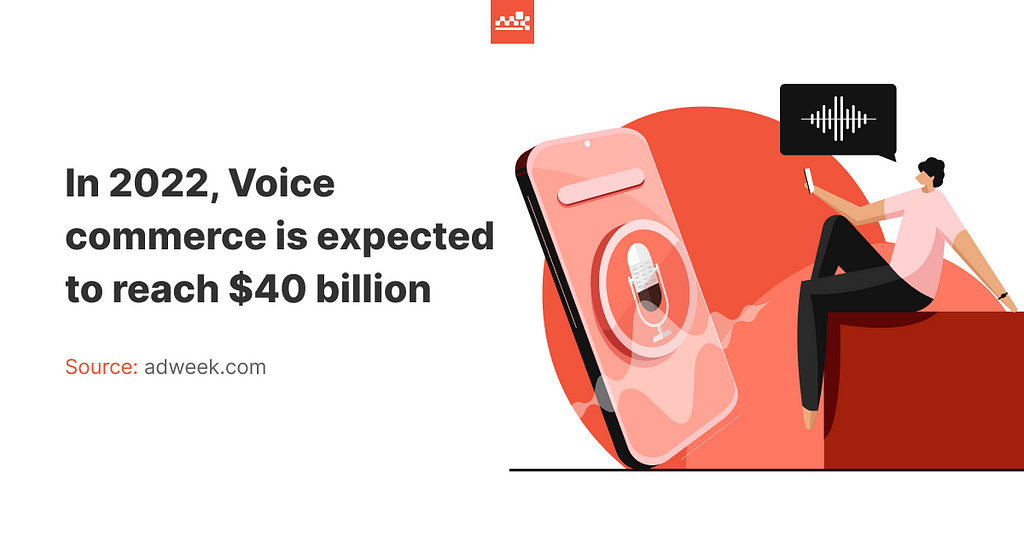Your cart is currently empty!
Month: September 2021
-
5 Ways Email Virtual Assistants Elevate Customer Shopping Experience
Have you witnessed the rapid growth of digital shopping assistants post-pandemic, across voice, email, or chat?
-
Scale Your Business with AI-Powered Enterprise Virtual Assistants

Growth is desired by all businesses but in order to grow and upscale a business, a lot of resources are needed. Apart from the right business strategy, you need a lot of people to execute tasks,
Highlights:
- What is an Automated Virtual Assistant?
- How can AI-powered Virtual Assistants help Scale your Business Up
- Automating Business Workflow
- Better Customer Relationship Management
- Concerns and Challenges with AI Virtual Assistants
- Proper Design of Use Cases and Initial Training
- Privacy and Security
Well, maybe not anymore now because the technology of artificial intelligence has raised to the point that they have the power to automate a lot of business tasks with a higher degree of accuracy and efficiency. With digital transformation accelerated by pandemics, many people are shifting to including virtual assistants at least in some areas of business.
Here in this article, let us discuss all essential things regarding these AI-powered Enterprise Virtual Assistants — — What they are, how they help, and some challenges they present.

What is an Automated Virtual Assistant?
An artificial intelligence virtual assistant is software that can effectively occupy the position of virtual assistant and carry out much of all expected tasks, like managing interactions, scheduling tasks, and much more.
You may have already experienced personal assistants in your mobile, pc and in other ways too. Think of Siri, Alexa, Cortana, and Google Assistant. All these assistants are already powerful in understanding the intent of their users and satisfying their requests. So, no wonder people would think of using AI-powered virtual assistants for their business needs.
The practice of hiring virtual personal assistants has been there for a long time. Business owners used to hire a person, many of them sometimes to be their virtual assistants and carry out many of their important tasks.
Digital virtual assistants use various technologies of Artificial Intelligence, Machine Learning including NLP (Natural Language Processing) NLU (Natural Language Understanding) for performing their tasks. A great thing with machine learning models is that the more data they receive, the more accurate they grow.
Not only through text, they also support interaction through voice which is a great advantage.
With a small yet crucial initial training, they can harness their already trained machine learning models to quickly start becoming your virtual personal assistant.
Also, these assistants would be available 24 hours a day, 7 days a week throughout the year!
Trending Bot Articles:
2. Automated vs Live Chats: What will the Future of Customer Service Look Like?
4. Chatbot Vs. Intelligent Virtual Assistant — What’s the difference & Why Care?
How can AI-powered Virtual Assistants help Scale your Business Up
Artificially intelligent virtual assistants are designed so that they can understand your intent accurately not only through your immediate message but also across various data channels and perform automation over vast environments for executing required tasks.
Automating Business Workflow
Your business workflow might include a lot of repetitive tasks or certain tasks that can be easily done by software. A report by McKinsey in 2017 states that 60% of all occupations contain at least 30% of activities that are automatable! Many years into the future, as automation is steadily being used in industry, we can see that much of all activities that can be automated have been automated now and this trend will only increase in the future.
By saying “automatable” tasks, they do not necessarily mean only customer service or general scheduling. While they are important, many other tasks like Marketing, Human Resources Management & recruitment can also be automated!
The virtual AI assistant you use can integrate itself with a wide range of solutions you already use for performing these tasks.
Better Customer Relationship Management
An intelligent virtual assistant not only helps in turning leads to customers but also provides a lot of help in maintaining customer relationships in resolving their problems and queries.
Instead of dedicated employees working round the clock to attend to all requests, virtual assistants can be deployed to automate and manage many customer problems. When correctly integrated, they also have the power to solve a range of queries including giving insights and tracking product delivery. They can also notify your customers when appropriate.
Concerns and Challenges with AI Virtual Assistants
Just as with many solutions, using a virtual assistant bot in your business has a lot of advantages and also presents challenges too. These are some prominent challenges with using AI-powered virtual assistants:
Proper Design of Use Cases and Initial Training
All of the virtual assistant platforms are pretrailed well and come with a lot of features. However, it is only in your hands to design it perfectly with use cases. While there are platforms that may do that too for you, it is ultimately you who knows what your personal assistant must do.
That is, you just design robust use cases that perfectly justify business uses and make use of all features of Virtual assistant. This might take some time but provides very valuable returns.
Privacy and Security
As technology occupies every aspect of your life, privacy becomes a huge concern. All of your activities might be recorded by the company and fed into their big data pool. While some are okay with it, many are not. It is up to you to decide which level of privacy you want.
Also, popular platforms often become targets for hackers, and as such even though a company vows to protect your privacy, it might be susceptible to malicious attacks.
Even though a company protects your data very tightly, there are still chances an attack could happen in the arguably weakest link — humans. Social engineering attacks are being more sophisticated and the price of not being aware would be high.
Final Words
Businesses, especially smaller ones, have been long using virtual personal assistants to decrease the load on them and outsource much of their work.
These people would be trained in many skills and work mainly on an hourly basis. Artificial intelligence-powered enterprise virtual assistants are being more and more popular because they work perfectly well as personal assistants all while providing the benefits of being digital — — maximum uptime and minimum costs.
As much as they have advantages, they have their challenges and concerns. It is up to you to make perfect use of technology all while being safe.
By taking much of the administrative and repetitive tasks out of you, virtual agent software would ultimately take a lot of burden out of you. With this, you get a lot of time to focus on improving your business which ultimately, Increases sales and makes you profits!
Don’t forget to give us your 👏 !



Scale Your Business with AI-Powered Enterprise Virtual Assistants was originally published in Chatbots Life on Medium, where people are continuing the conversation by highlighting and responding to this story.
-
Voice Assistant Use Cases: Business Implementations of VUIs in 2021

Amazon’s Alexa, Apple’s Siri, Microsoft’s Cortana, and Samsung’s Bixby may be the flag bearers of voice assistants (VAs) but the technology itself is no longer limited to megacorporations. Instead, it is finding its way to numerous enterprise-level applications. This new wave of adoption is evident in recent statistics too:
- Global Banking and Finance Review reported that 88 percent of global business leaders think that voice assistant technology has the potential of growing their businesses.
- On the consumer side, a survey from Google reported that 72 percent of Google Pixel’s users use the phone’s AI voice assistant daily.
Additionally,52 percent of those consumers expressed that they would like to receive information about various products and brands via voice assistants. - Artificial intelligence (AI) and machine learning have breathed a new life into VAs and are now reshaping consumer behavior trends, which opens up a plethora of opportunities for businesses to capitalize on. Not surprisingly, they have.
In this article, we’re taking a look at some of the popular use cases for voice assistants for businesses as well as the benefits driving these implementations.

Why Are Businesses Investing in Voice Assistants (VAs)?
Voice assistants typically found on mobile devices like Siri and Google Assistant are examples of Voice User Interfaces (VUIs). Although VUIs have existed as early as the 1950s, greater technological challenges meant that modes of communication like typing took precedence in most business implementations.
However, most of those technological barriers have been overcome and VUIs of today offer many important advantages over their counterparts, like:
1.Speed
As accustomed as some of us have become to typing, speaking (or dictating messages) is still a much faster way of communicating. A study showed that even expert typists were not faster than modern VUIs at taking down messages.2. Hands-free
Another major benefit of using voice assistants is having both hands free. This further expands the possibility of multitasking, especially for employees who often have to stop what they are doing in order to respond to an urgent text message or send a file to a colleague.But not only can voice assistants improve productivity in and around the workplace, but they can also improve safety. In many cases including driving or cooking, being able to communicate through voice instead of typing is both more practical and safer.
3. Easy-of-use
Speaking is natural, more so than typing even in 2021. This becomes especially important when the technology is consumer-facing. For instance, a parking lot’s automated toll booth or an iPad taking customer feedback are both far more intuitive when they are designed to both understand the user’s verbal commands and provide assistance. Not to mention, VUIs began their comeback only recently so the technology is still a novelty that many customers would enjoy.4. Intonation
Text messages often lack factors that convey emotion, often leading to ambiguity and even miscommunication. Voice assistants, on the other hand, are designed with the tone, volume, intonation, and rate of speech in mind to convey a greater range of emotions.5. Screenless Devices
Finally, with wearable tech with displays like smartwatches and IoTs like smart speakers, voice is the only way of interacting effectively. This is both an incentive to invest in VUIs as IoTs will become more commonplace and also a benefit of already pursuing this technology.Trending Bot Articles:
2. Automated vs Live Chats: What will the Future of Customer Service Look Like?
4. Chatbot Vs. Intelligent Virtual Assistant — What’s the difference & Why Care?
How Businesses Are Using Voice Assistants or VUIs in 2021
The ability to speak and get things done has virtually unlimited use cases but the following five use cases explore the most popular implementations of voice assistants or (VUIs in general):
Embeddable Voice Assistant Technology for Chatbots
Text-based chatbots have become very commonplace, especially in retail, eCommerce, and banking applications. And since improving customer experience is the top priority, many businesses want to add voice recognition capabilities to their existing applications.
Embeddable Voice Assistant is a technology developed by Master of Code that allows existing mobile apps to communicate with Microsoft Azure Bot via Direct Line (or any other bot framework). This brings voice assistant capabilities to existing apps at a fraction of the cost of developing a voice assistant from the ground up.
Consumer Products and Retail
A recent report on voice and text-based assistants found that consumers of the retail industry demonstrated a 15 percent higher future preference of voice assistant technology to chat assistance. There are a few reasons behind this shift, one of the most prominent reason being that many online shoppers need a more efficient alternative to browsing dozens of product pages in modern eCommerce stores. Voice assistants effortlessly direct them to the relevant products through a single voice command.

According to Mckinsey Global Institute Research Voice Payments
The finance industry has been using voice-enabled devices to save time and enhance customer service, which is key in developing business in this industry. For example, Garanti, a Turkish bank, has developed a Mobile Interactive Assistant (MIA). Customers can use MIA to use their mobile banking app through voice commands. The communication isn’t one-way either. The voice assistant can also notify the customer about recent promotions/offers and analyze their usage patterns to create a personalized experience.
This is a big move as it helped dispel some of the security concerns surrounding voice-based chatbots. And as financial bodies continue to embrace voice-based technologies, the adoption rate in the sector will rise.
Business Insider says that the use of voice payments will grow from 8 percent to 31 percent of US adults by 2022.
Another reason why voice payments are emerging as a prominent means of payment is that consumers are driven towards a cashless payment alternative that’s faster and more seamless than tap-n-pay options available today. That said, VA technology still has some ways to go before it becomes mainstream in the banking sector, mostly because of the security challenges it entails.
Improving productivity within the organization
Apart from enhancing the consumer experience, AI-based voice assistant technology offers great potential to increase a company’s productivity levels. Results from a survey indicated that using digital assistants can compensate for up to 6.2 billion work hours. This is not just effective; it offers companies to achieve superhuman levels of productivity and minimize human labor wastages. The Capgemini Research Institute Survey found that enterprises are increasingly relying on increasingly accurate natural-language understanding (NLU) to trigger various automated workflows with voice commands, especially in areas such as document management, customer relations management, and HR.
AI-powered voice assistants are also capable of processing and analyzing extremely large chunks of data. This can be used to automate repetitive tasks or labor-intensive tasks. An interesting implementation of this can be found in numerous HR departments around the world. HR managers rely on voice assistants to evaluate multiple recruitment databases simultaneously and add a conversational medium between the applicant which can be further used for automated screening. Furthermore, VUIs like Darwin give employers an easy to evaluate team performance, view attendance, payrolls, etc.
Collecting feedback and developing strategies
VA bots can gather consumer data about their interests which a human cannot. A company can use this data to understand trends in consumer interests and develop products and marketing strategies accordingly. Currently, voice shopping is valued at $2 billion and is expected to hit a whopping $40 billion by 2022. Therefore, global brands like Johnnie Walker and L’Oreal are partnering with companies like Amazon to make their product information easily accessible through Alexa and other Voice User Interfaces (VUIs).
VUIs have such a large market that companies have started considering voice technology in product design, delivery, and marketing strategies to better connect with their customers.
Voice Assistant: Customer feedback strategy Inclusiveness and Accessibility
Every organization has users with motor and linguistic disabilities that make it difficult for them to use certain types of interfaces — handheld or text-based interface being one of them. And even though nearly one billion in the world experience some form of disability, most computer systems aren’t designed for inclusiveness — in essence creating a barrier for nearly 15% of the population.
Federal legislation like the Americans with Disabilities (ADA) is helping improve the situation but compliance can be very expensive (non-compliance even more so). This is where voice assistants offer a cost-effective solution by providing both verbal and visual aid by not requiring users to read the text on the screen or be able to touch it (type responses back into it). In fact, a peer-reviewed study from 2020 found that users with disabilities could effectively use voice assistants and take control over daily tasks (which would be a great boost for mental health as well).
Voice assistants also ensure that individuals with temporary disabilities like hand fractures can still use their favorite mobile apps.
Advertising and Marketing
The eCommerce global market has increased to a noteworthy $4.28 trillion, a 320 percent increase since 2014. As a result, many businesses have switched to digital marketing to support this shift. Mass marketing, especially out-of-home (OOH) advertising is becoming a less appealing form of marketing for enterprise-level businesses every year. And companies are speaking with their wallets on this because the global print advertising market has plummeted by a compound annual growth rate (CAGR) of — 9.82 percent, dropping down from $39.3 billion in 2019 to $35.44 billion in 2020.

Sources: Capgemini Research Institute, Conversational Interfaces Research Instead, as consumers begin to spend more time on their smartphones and computers, the most effective way to advertise is shifting in the favor of voice technology. As consumers embrace VAs as a normal part of their life, the way they interact with marketing campaigns is also changing considerably. Forecasts suggest that global marketing efforts will continue focusing heavily on VAs simply. Some of the reasons behind this shift include:
- voice assistants offer personalized recommendations and offer to users making them more effective
- marketing strategies such as upselling and cross-selling can be employed more naturally through voice
- VAs provide direct consumer insights and feedback to marketers.
Where Conversational User Interface Is Headed
Voice assistants are a part of a broader spectrum of Conversational User Interfaces that also include text-based chatbots. The emerging popularity of these conversational user interfaces is the result of a major global shift to make everything conversational — from controlling your home electronics to creating a digital shopping list.
But like all consumer trends, is conversational user interface like VAs and chatbots going to go out of fashion? Perhaps at some point but certainly not for the next few decades. If anything, the technology will only grow as 64 percent of consumers want their AI virtual assistants to be more human-like.
For now, VA technology is changing the business landscape as evident by these voice assistant use cases. From eliminating human redundancies to making business operations more efficient to improving customer engagement, voice technology is being rapidly incorporated across industries all over the world.
Don’t forget to give us your 👏 !



Voice Assistant Use Cases: Business Implementations of VUIs in 2021 was originally published in Chatbots Life on Medium, where people are continuing the conversation by highlighting and responding to this story.
-
I am trying to create a price quote-generating chatbot and I’d like some guidance with this, anyone here who can help me out?
I’ve got a few questions:
- Where do I get started? I’ve created a basic chatbot with the help of a YouTube tutorial, it just answers questions that I’ve given the answers to.
- What are the algorithms that I need to learn?
- This is for a project and I need to find a research gap in this project idea, what could be a possible research gap for this idea?
Highly appreciate any kind of help or advice!
submitted by /u/killMontag
[link] [comments] -
Career change
Hi guys!
I am coming from a very different industry and I want to switch my career to a chatbot developer or a conversational designer. Would you recommend such a career change? I am a civil engineer but I am also familiar with coding. Is there a future in chatbots? Or maybe the demand is low? Any info would be appreciated.
Thank you!
submitted by /u/thames78
[link] [comments] -
7 Applications of Chatbots in the educational Industry

Students prefer personalized interactive learning. AI-powered learning tools like chatbots or intelligent virtual assistants are bringing this learning experience to the hand of every student. In this article, we explore 7 applications of Chatbot in the education industry and how they are influencing the educational platform.
submitted by /u/Mysterious_Ad_878
[link] [comments] -
Effective chatbot re: loneliness
I have developed a conceptual framework for chatbots that includes three primary types:
-
Informational (e.g. help me find information about X)
-
Instrumental (e.g. help me figure out if I have X disease, or make an appointment with Y, or resolve my difficulty with Z)
-
Intrapersonal (e.g. help me feel less lonely, bored, angry, etc.)
The first two categories are replete with developed and performing examples. The last category is lagging.
Is anyone here aware of any chatbot(s) that actually work to reduce a sense of loneliness among users? Even any that show promise? I find articles about people with intentions, but precious little information about successes.
submitted by /u/grudoc
[link] [comments] -
-
Virtual Healthcare Assistant Army With Workbots

According to a recent report in the New Scientist, hundreds of thousands of people say ‘Good morning’ to Alexa every day. AI chatbots are everywhere and people are showing a huge interest in digital assistants. This could imply that chatbots will take over messaging applications someday across many business sectors. Healthcare is one such segment where we have seen limitless possibilities of growth. Healthcare assistants offer more than just information. They gather information through conversations and also analyse patients’ symptoms. This is possible because of Artificial Intelligence technologies and Natural Language Processing that help chatbots to converse in a more human-like manner.
According to the global tech market advisory firm ABI Research, AI spending in the healthcare and pharmaceutical industries is expected to increase from $463 million in 2019 to more than $2 billion over the next 5 years.

Virtual healthcare assistants can provide high-quality medical assistance in a very cost-effective way. AI Chatbots can help provide advanced patient care, improve patient experiences through virtual diagnosis and data analysis which in turn empowers patients to be more proactive about their health.
What is a Healthcare assistant capable of doing? Here’s how you can create an army of digital assistants!
- Consultation and advice
Digital healthcare assistance can consult with patients and give advice. A lot of common healthcare issues do not require doctors’ intervention. Chatbots can find a solution and answer patient’s queries by analysing symptoms through Artificial Intelligence. The main goal is not to replace doctors or doctors’ diagnoses but to provide timely basic medical aid.
- Managing prescriptions
Suppose a patient does not take medicines on time and often misses his dose. Just inform the chatbot about the name of the medicine, the number of times it has to be taken during the day and it will remind patients to have their pills on time.
Trending Bot Articles:
2. Automated vs Live Chats: What will the Future of Customer Service Look Like?
4. Chatbot Vs. Intelligent Virtual Assistant — What’s the difference & Why Care?
- Booking appointment
Chatbots can automate the booking process. It streamlines patient workflow, directing them based on expressed symptoms. Tasks like confirmation of appointments, rescheduling, termination can be done by bots speeding up transactional patient queries, thus freeing up receptionists to concentrate on patients coming through OPD (Outpatient Departments)
- Diet and exercise advice
In this age where diet and exercise play a major role in most people’s lives and being fit is the #1 priority, a chatbot can act as an assistant to track and advise patients’ dietary needs according to their physical capabilities. Apart from that, post-operative diet and follow-ups can also be done through chatbots.
- Symptoms checking and screening
Healthcare chatbots can screen patients on a massive scale via analytic insights. A healthcare bot can converse simultaneously with thousands of people anytime. No matter the magnitude of questions, healthcare bots can provide answers immediately. Checking of symptoms can enable chatbots to derive statistics based on algorithms and offer solutions to patients.
For example, a new mother would have a thousand questions regarding her baby. She would not go out of the way to ask her pediatrician to whether her baby is sleeping enough. These questions are relevant but do not require medical professionals’ assistance. A symptom checker can analyse the baby’s symptoms and derive a conclusion on whether the baby needs to be brought in for a check-up or provide solutions for treatment at home.
A study published in the Journal of Paediatrics found that 56% of websites provide inaccurate or irrelevant health-related information.
What does the future holds?
There is literally no end to what chatbots can do to enrich our lives. Digital health assistants can manage health very efficiently. It will get better as the chatbot continues to learn and evolve through patient interaction. Someday we might be able to share our medical reports with chatbots and they might be able to offer wise solutions or perhaps to even “trick us” into attaining good health with gamification nudges. AI-driven chatbots in healthcare are continually growing and promising care through streamlined systems.
Don’t forget to give us your 👏 !



Virtual Healthcare Assistant Army With Workbots was originally published in Chatbots Life on Medium, where people are continuing the conversation by highlighting and responding to this story.




